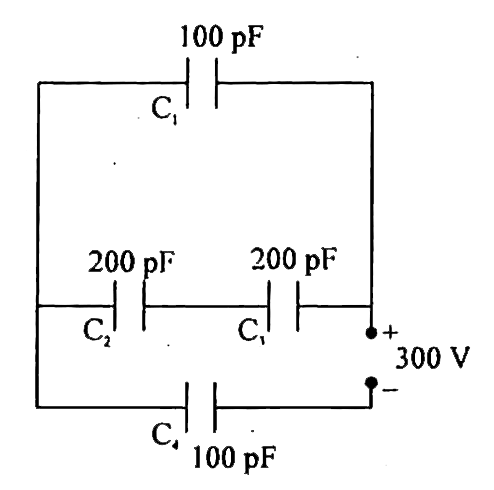Complete Solutions to NUMERICALS WITH SOLUTIONS of chapter ELECTROSTATIC POTENTIAL AND CAPACITANCE of Class 12 book with complete answers and questions
| Class 12 | PHYSICS |
| Chapter | ELECTROSTATIC POTENTIAL AND CAPACITANCE |
| SUBHASH PUBLICATION | NUMERICALS WITH SOLUTIONS |
| Number Of Questions | 20 |
| Academic Year | 2023-24 |
A spherical hollow conductor is charged to -250V. If the radius of the conductor is 0.15m, then calculate
(i) Charge on the conductor.
(ii) Electric files intensity on the surface
(iii) Electric field intensity at the centre.
(iv) Electric potential difference between A and B at distances of 0.20 m & 0.25m from the centre respectively.
View SolutionThree point charges `+10nC,-15nC and +20nC` are placed at the corners A,B and C respectively of a square, ABCD of side 0.1m. Calculate the amount of work done to transfer -100nC from the point 'D' to the point 'O'.
View SolutionCalculate the amount of work done by a uniform electric field of 200 `Vm^(-1)` on an electric dipole of length 0.05m and charge 40nC in order that the angle between the axis and the field is equal to `180^(@)`, what is the amount of torque required to maintain that position?
View SolutionCalculate the number of electrons to be transferred from a material body in order to charge it to +5.5 nC.
View SolutionThe effective capacitances of two condensers are `3muF and 16muF`, when they are connected in series and parallel respectively. Compute the capacitance of each condenser.
View SolutionA parallel plate capacitor consists of two circular plates of radius 0.05 m each, which are separated by a distance of `1.2xx10^(-3)m`. Calculate its capacitance. If the difference between the two plates is reduced to half the initial value, then calculate its capacitance.
View SolutionWhen two capacitors are connected in series across a 2kV line, the energy stored in the system is `5((5)/(11))`J and when connected in parallel to the same voltage line, the energy stored in the system is (22)J. find the capacitances of the individual capacitors.
View SolutionTwo capacitors `3muF and 5muF` are charged to 18V and 25V respectively. These are then connected in series. Calculate the net voltage and net charge. Find the loss of energy after connecting them in series.
View SolutionTwo capacitors `1muF and 3muF` are charged individually to voltages of 100V and 200V respectively. These are then connected in a parallel combination. Find the loss in the energy stored in the capacitors.
View SolutionThree concentric metallic spheres A, B and C of radii 1m, 2m and 3m respectively are charged to 0.56 nC, 2.12 nC and 5.0 nC. Calculate the potentials of the spheres.
View SolutionA parallel capacitor collects a charge of `3muC` when connected to a 1.5 V battery with air as dielectric. On replacing the air with a dielectric material the capacitor collects `9muC` of charge. Find the dielectric constant of the material and also the energy stored in it with the material as dielectric.
View SolutionYou are provided with 3 capacitors, each capacitance `2muF`. In how many possible ways can you connect these capacitors. Calculate the capacitance of each of the combinations.
View SolutionTwo charges `5xx10^(-8)C and -3xx10^(-8)C` are located 0.16 m apart. At what point(s) on the line joining the two charges is the electric potential zero?
View SolutionA spherical conductor of radius 0.12 m has a charge of `1.6xx10^(-7)`C distributed uniformly on its surface, what is the electric potential?
(a) inside the sphere?
(b) Just outisde the sphere?
(c) At a point 0.18 m from the centre of the sphere?
View SolutionA parallel plate capacitor with only air between the plates has a capacitance of `8pF`. What will be the capacitance if the distance between the plates is reduced by half and the space between them is filled with a substance of dielectric constant 6?
View SolutionThree capacitors each of capacitance 9pF are connected in series.
(a) What is the total capacitance of the combination?
(b) What is the potantial difference across each capacitor if the combination is connected to a 120 V supply?
View SolutionObtain the equivalent capacitance of the netwrok in the figure given below. For a 300V supply, determine the charge and voltage across each capacitor.

View SolutionA parallel plate capacitor is to be designed with a voltage rating 1kV, using a material of dielectric constant 3 and dielectric strength about `10^(7)Vm^(-1)`. For safety, we should like the field never to exceed, say 10% of the dielectric strength. what minimum area of the plates is required to have a capacitance of 50 pF?
View SolutionA molecule of a substance has a permanent electric moment of magnitude `10^(-29)Cm`. A mole of this substnace is polarised by applying a strong electrostatic field of magnitude `10^(6)Vm^(-1)`. The direction of the field is suddenly changed by a angle of `60^(@)`. estimate the heat released by the substance in alighning its dipoles along the new direction of the field. for simplicity, assume 100% polarisation of the sample.
View SolutionThe area of a parallel plate capacitor is `6xx10^(-3)m^(2)`. The distance of separation of two plates is `3xx10^(-3)m`. Calculate the capacitance of the above capacitor. If the capacitor is charged to potential of 100 V then calculate the charge on each plate.
View Solution
NUMERICALS WITH SOLUTIONS questions and complete solutions for chapter ELECTROSTATIC POTENTIAL AND CAPACITANCE of JEEVITH PUBLICATIONS PHYSICS (KANNADA ENGLISH) of Class 12